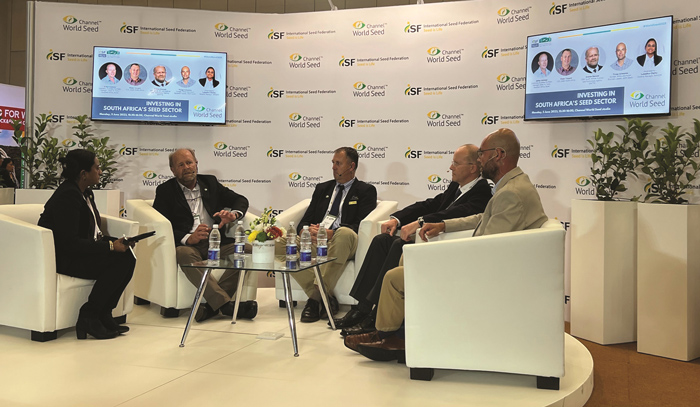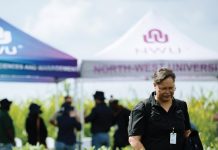
SA Graan/Grain contributor
The expansion of South Africa’s soybean industry is a success story that has led to more sustainable and profitable cultivation and crop rotation practices, processing capacity, and the substitution of imported soybean oil cake and oil with locally produced and processed products. In addition to that, these developments in the soybean industry have played a major role in the new-found profitability of many producers in the summer rain production areas, especially west of the N1.
During a panel discussion at the recently held World Seed Congress of the International Seed Federation (ISF), Dr Lukeshni Chetty, general manager of the South African National Seed Organisation (SANSOR), delved into the nuts and bolts of the end-point royalty system: how it boosts investments for innovative breeding programmes and thereby contributes to sustainable agriculture in South Africa.
The panellists taking part in the discussion were Andrew Bennett (CEO of SACTA), Dr Pieter Taljaard (CEO of Grain SA), Arthur Schröder from Bayer Crop Science and Thiago Schwonka from GDM Seeds.
Breeding and technology levy
In a cooperative industry drive, the South African Cultivar and Technology Agency (SACTA) was created in 2016 to collect and administer breeding and technology levies for self-pollinated crops in South Africa. The end-point value capture system in South Africa is administered by SACTA and is the product of an industry-wide initiative including SANSOR, representing the South African seed industry; Grain SA, representing grain and oilseed producers; Agbiz Grain; and the Oilseeds Advisory Committee (OAC), representing the oil seed industry. The collection of the end-point levy is undertaken in terms of a statutory instrument governed under the Marketing of Agricultural Products Act, 1996 (Act No. 47 of 1996).
According to Bennett, the breeding and technology levy is a fair and sustainable value-capturing system that was introduced to drive innovation down the entire value chain.
An investigation into the future viability of the current soybean breeding and technology levy system recently conducted by the Bureau for Food and Agricultural Policy (BFAP), indicated that the levy system was a landmark breakthrough in keeping the soybean industry viable and that it ensured that producers gained access to the latest varieties and technologies.

Benefits of the levy
The envisaged benefits of the levy may be found in the expansion of the soybean industry over the past three years. During the 2021/2022 production season, the area planted to soybeans was 925 000 ha compared to 46 000 ha in the 1992/1993 production season. The local production of soybeans increased from 1,3 million tons during the 2016/2017 season to 2,09 million tons during the 2021/2022 season. During this period, the area planted to soybeans increased from 574 000 ha to 925 000 ha. According to the latest figures for the 2022/2023 season, more than a million hectares of soybeans with an estimated yield of 2,7 million tons were produced.
According to Schröder, the promise of new improved varieties and technologies created the platform for growth and confidence with the private sector and producers starting to look to soybeans as a viable rotation crop option in a broader production area.
The 2020, 2021 and 2022 levy collections have been successful and to a great extent achieved the intended goal. With a proven functioning value capturing system in place, seed companies are willing to invest in and bring more technology to South Africa, even though the country is a relatively small soybean producer, where more than 80% of seed is farm-saved seed.
Bennett emphasised that the SACTA breeding and technology levy should be seen as a method to drive innovation in the value chain and an investment into the sustainability of the grain market in South Africa.
Although producers might be wondering why they should be paying for technology that has not been launched yet, the truth is that the benefits of the levy are starting to come through. ‘The entire system is aimed at driving producer profits and crop productivity,’ Dr Taljaard explained.
The levy is enabling breeding programmes to afford access to new sources of germplasm, bio-technology, better equipment, tools and infrastructure and to participate in the value chain with international expertise.
Allocation of funds
Of the collected amount, a maximum of 5% is allocated to administration and collection services, and 20% to development/transformation. Of the remaining 75%, 16,67% is allocated to the technology trait owner/s, and the remainder to the owners of the germplasm in accordance with their market share. With the advent of new technologies, the portion allocated to technology is increasing to 21%.
In the recent past, 56 new soybean varieties have been registered in South Africa, substantially increasing soybean variety choices for producers and making the industry more competitive. An additional benefit has been the lowering of seed prices.
Seed companies also started with trials to initiate the deregulation process for new traits as well as to register new varieties. In August 2021, the first of these, Intacta® Roundup® Ready2 was launched. Intacta RR2Pro is the second genetically modified soybean trait to be approved for cultivation in South Africa, after the first Roundup Ready soybean trait was approved back in 2001. This means that local producers now have access to technology that has been available on the global market for the past six years, but also that newer varieties containing the trait can be imported for cultivation.
An example that needs to be mentioned, according to Dr Taljaard, was the recent case where soybeans could not be exported to Turkey due to the MRL (minimum residue limit) status. ‘With the new INTACTA technology that was brought into South Africa as part of the new soybean impetus, this situation could be addressed and MRL levels could be brought down substantially,’ he said.
Two other companies are also in the process of deregulating their traits and it is expected that these could be available to the market by 2025/2026, further broadening the producer’s choices.
South Africa’s soybean yield has the potential to increase by 50% over the next five years with new seed germplasm, GM events, precision farming technology and improved farm practices.
This end-point value capture system is an example that can be implemented in other countries.
‘It is an example of collaboration of industry role-players that benefits the entire value chain and acts as an incentive for seed companies to invest in South Africa,’ Bennett said.
According to Schröder, Bayer is already working on the next generation of technologies and if this system remains viable, it can bring benefits to both producer and industry.
Looking ahead
Regarding the future of the system, Dr Taljaard said that producers would be willing to pay if they saw results and benefits flowing from the programme. ‘With all the challenges facing them in South Africa, producers cannot farm without the technology brought by multinational companies. With this system that benefits both the producers and the companies, it is a win-win situation for both parties. South African producers are willing to test new technologies and innovative models and to share the production risk.
‘We need to check every season that producers are still satisfied with the system. The sustainability of the systems is based on producers seeing the benefit.’
Schwonka mentioned that South Africa was an entry point and opportunity to the rest of Africa. ‘We accept that as companies we have the responsibility to bring new germplasm to countries so that we can help producers to be more profitable, but at the same time we also need structures and systems that can guarantee that the germplasm will be protected.’
In the end, Dr Chetty said, although it was important that both seed companies and producers were making a profit, it was crucial that the entire industry worked together to achieve a common goal – food security and sustainable cultivation practices. That was the ultimate goal of the end-point levy system.



















